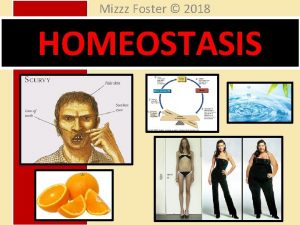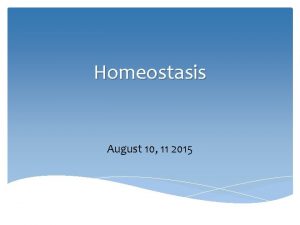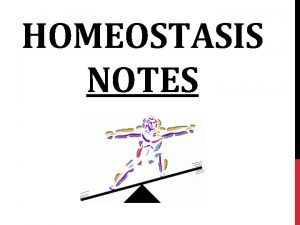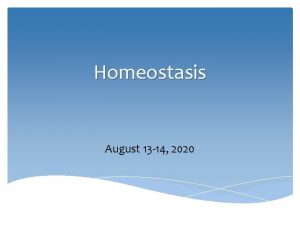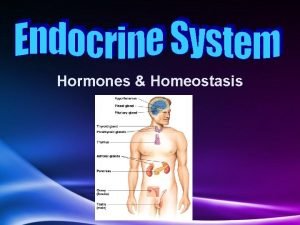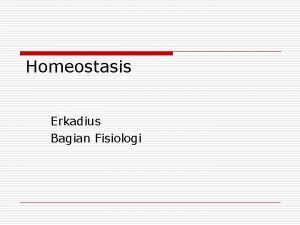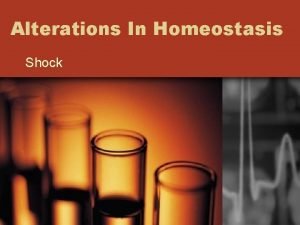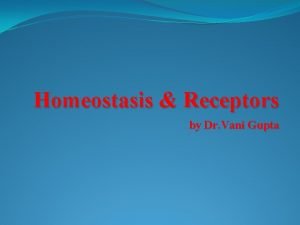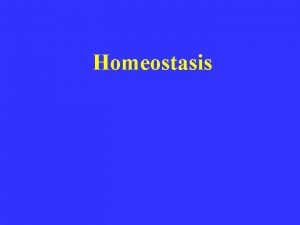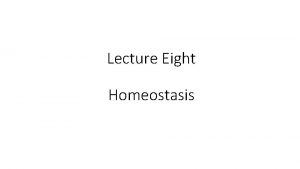Homeostasis August 10 11 2015 Homeostasis The maintenance






















- Slides: 22

Homeostasis August 10, 11 2015

Homeostasis The maintenance of relatively stable internal conditions Dynamic process – the body is constantly regulating to keep conditions within acceptable ranges

Examples of Homeostasis Many variables are maintained by homeostasis. What examples can you think of?

Examples of Homeostasis Many variables are maintained by homeostasis. Examples include: Temperature Blood p. H Blood sugar Water balance Blood pressure Ion balance

Homeostatic Control Mechanisms

Homeostatic Control Mechanisms Analogies Thermostat Cruise control others?


What is the. . . Variable? Stimulus? Receptor? Control center? Effector? (some may not be listed on chart)

What is the. . . Variable? Stimulus? Receptors aren’t shown on this picture, but there are two sets of thermoreceptors: some in the hypothalamus to measure internal temperature , and some in the skin to measure external temperature Control center? Effector?

You do: What is the. . . Variable? Stimulus? Receptor? Control center? Effector?

Receptors aren’t shown again, but there are two types of calcium receptors scattered throughout the body You do: What is the. . . Variable? Stimulus? Receptor? Control center? Effector?

Negative Feedback Mechanisms Most homeostatic mechanisms are examples of negative feedback. In negative feedback, the output acts to change the direction of the stimulus. Example: If the body is hot, the hypothalamus will activate the sweat glands and dilate the blood vessels (the two outputs) … both of which will act to reduce the body temperature.

Positive Feedback Mechanisms Some processes in the body are positive feedback mechanisms. In positive feedback, the output enhances the stimulus

Positive or Negative Feedback? Blood Clotting Blood Pressure

Positive or Negative Feedback? Blood Clotting Positive – The output (platelet adhering) increases the original stimulus (platelet-attracting chemical) Blood Pressure Negative– The output (decreased heart rate / increased diameter) decreases the original stimulus (high blood pressure)

Positive and Negative Feedback Come up with examples and non-examples of negative and positive feedback. (For non-examples, I want something that at first glance might seem like positive or negative feedback, but isn’t). What is it that distinguishes the true examples from the non-examples?

Homeostatic Imbalance Most disease is caused by a disturbance of homeostatic mechanisms known as homeostatic imbalance. Homeostatic imbalance can result from Aging Genetic mutations Pathogens Environmental factors

Congo Line review - 10 minutes -

Homework Chapter 1 outline due next class First quiz Aug 14 / 17!

Closure What are your key takeaways from our objectives? What was our LP and how did we use it? How does what we did today relate to our significant concept?

Exit Ticket Study this diagram. 1) What is the stimulus? 2) What are the effectors? 3) Is this + or – feedback, and how can you tell?

Exit Ticket Identify the body system to which each organ belongs 4) Pancreas 5) Liver Ex) Which system cleans and returns body fluids to the blood stream?
 Bioflix activity homeostasis high blood glucose
Bioflix activity homeostasis high blood glucose Bioflix activity homeostasis hormones and homeostasis
Bioflix activity homeostasis hormones and homeostasis Bổ thể
Bổ thể Từ ngữ thể hiện lòng nhân hậu
Từ ngữ thể hiện lòng nhân hậu Tư thế ngồi viết
Tư thế ngồi viết Ví dụ giọng cùng tên
Ví dụ giọng cùng tên Thơ thất ngôn tứ tuyệt đường luật
Thơ thất ngôn tứ tuyệt đường luật Chúa sống lại
Chúa sống lại Hổ sinh sản vào mùa nào
Hổ sinh sản vào mùa nào Diễn thế sinh thái là
Diễn thế sinh thái là đại từ thay thế
đại từ thay thế Vẽ hình chiếu vuông góc của vật thể sau
Vẽ hình chiếu vuông góc của vật thể sau Làm thế nào để 102-1=99
Làm thế nào để 102-1=99 Công thức tính thế năng
Công thức tính thế năng Tỉ lệ cơ thể trẻ em
Tỉ lệ cơ thể trẻ em Thế nào là mạng điện lắp đặt kiểu nổi
Thế nào là mạng điện lắp đặt kiểu nổi Lời thề hippocrates
Lời thề hippocrates Vẽ hình chiếu đứng bằng cạnh của vật thể
Vẽ hình chiếu đứng bằng cạnh của vật thể Quá trình desamine hóa có thể tạo ra
Quá trình desamine hóa có thể tạo ra Các môn thể thao bắt đầu bằng tiếng nhảy
Các môn thể thao bắt đầu bằng tiếng nhảy Hát kết hợp bộ gõ cơ thể
Hát kết hợp bộ gõ cơ thể Khi nào hổ con có thể sống độc lập
Khi nào hổ con có thể sống độc lập Các loại đột biến cấu trúc nhiễm sắc thể
Các loại đột biến cấu trúc nhiễm sắc thể























